DOLPHIN FLEET NARTURALIST NOTEBOOK July 11th-17th
We had ideal whale watching conditions on July 11th with bright skies, light wind and calm seas. While headed for Stellwagen Bank we observed over 15 humpback whales and 3 finback whales. We identified Alphorn, Aerospace, Elephant, Sundown, Pipette, Tulip and calf, Bolide and calf, Fern and calf. To our surprise the humpbacks were engaged in active behaviors throughout the day. Although active displays are often both repetitive and contagious, they are usually constrained to one or two sightings. We witnessed almost every active behavior, as many humpbacks were lobtailing, flipper slapping, tail breaching, chin breaching and spiral breaching. Even young calves were performing these elaborate behaviors. Fern’s calf for example was tail breaching, lobtailing and spiral breaching. Little is known regarding the purpose of lobtailing, however, some scientists speculate that it’s a form of communication or play.
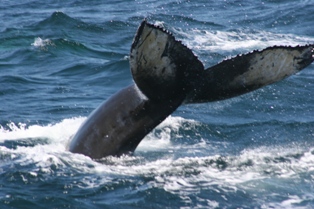
Fern’s Calf Lobtailing
We left Provincetown Harbor with gray skies, light wind and calm seas on July 12th. We observed 13 humpback whales, 1 finback whale and 1 minke whale on the South Edge of Stellwagen Bank. In the morning the whales were going on fluking dives and were traveling randomly, which may be suggestive of foraging. In the afternoon, however, the whale’s behavior became apparent as they were kick feeding and creating bubble clouds and nets. We observed Barb, Division, Tongs, Tear and Lavalier surface feeding. Some of the humpbacks were feeding cooperatively, as they were kick feeding and then going on shallow dives to release bubbles in the form of bubble nets to disorient and concentrate the prey. Once the prey had aggregated into a tight ball, the whales would surface through the bubbles with open mouths.
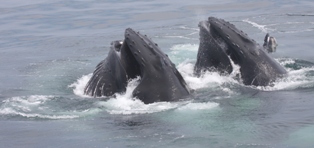
Feeding Humpbacks
July 13th was another great whale watching day with bright skies, low winds and calm seas. Our whale sightings were exceptional with 20 humpbacks, 6 finbacks, 5 minke whales and 1 basking shark. In the morning the Dolphin VI followed Ursa, Rune, Wizard, Tear and Sloop northward to the Southwest Corner of Stellwagen Bank. The whales were headed for a very rich area that was teeming with sand lance. As soon as the humpbacks arrived at their destination they began feeding, almost immediately forming bubble clouds and nets. Other whales were exploiting the sand lance resource, as several humpbacks and minkes were seen circling around their prey. Hundreds of sea birds had also aggregated, with sooty, greater and cory shearwaters diving down in hopes of catching individual fish. Banyon, Soot, Giraffe, Sirius, Salt, Pipette, Tulip, Sundown, Cardhu and many others were all kick feeding.
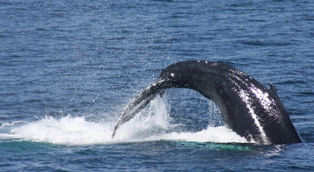
Kick Feeding Humpback

Lunge Feeding Finbacks
We sailed out to Stellwagen Bank on July 14th with optimal sighting conditions, bright skies, light wind and calm seas. Our sightings were outstanding with 35 humpbacks, 2 finbacks and 2 minke whales. In the morning the whales appeared to be on a set path as they were going on fluking dives and were traveling linearly. In the early afternoon, however, the whales aggregated just East of Stellwagen Bank, where they were feasting on their favorite prey—sand lance. We observed Dome, Echo, Cygnus, Ursa, Leukos, Shuffleboard, Coral, Baja, Milkweed, Strike, Flounder and Rapier kick feeding and making bubble clouds and bubble nets. Barb, Percussion and Liner appeared to be feeding cooperatively, as they were enclosing their prey in large bubble nets. Some humpbacks such as Evolution, Reflection, Sirius and Milkweed were lunging through the prey patches on their sides with their mouths open. Usually humpbacks will reserve this feeding strategy for when the prey is densely concentrated at the surface.
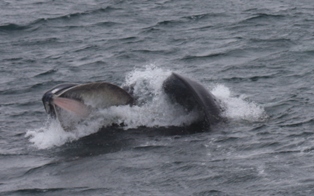
Lunge Feeding Humpback
July 15th was another beautiful day to be out on the water with bright skies, light wind and calm seas. We observed three species of baleen whale with over 15 humpbacks, 4 finbacks and 3 minke whales. The whale’s behavior was diverse throughout the day. In the morning the Dolphin VII saw Coral breaching and moments after leaving Coral they came across Isthmus who was feeding. The afternoon was quite similar with several humpbacks open mouth feeding. The Portuguese Princess saw Filament, Ursa, Aerospace, Rocker, Coral, Dusky, Etch-a-sketch and Tracer all kick feeding. Meanwhile, the Dolphin VIII observed a myriad of active behaviors such as breaching, flipper slapping and lobtailing from Anvil and her calf.
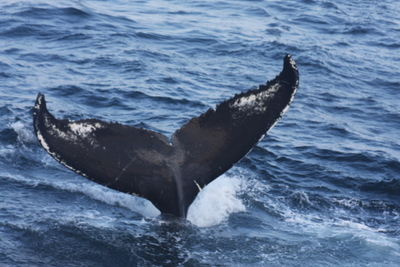
Isthmus
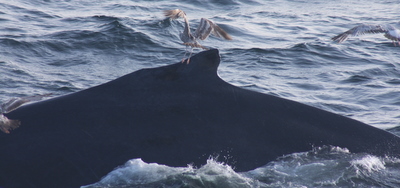
Isthmus
On July 16th we sailed into Cape Cod Bay with bright skies, moderate wind and seas. We had exceptional sightings, with 43 humpbacks and 4 finbacks. We Identified Tongs, Tracer, Ursa, Liner, Venom, Pipette, Cajun, Canon, Hancock, Dome, Entropy, Buckshot, Shuffleboard, Vulture, Glostick, Peninsula, Alphorn, Crown, Putter and Nile and calf. The whale’s continued to exhibit a wide array of behaviors from active playful behaviors to surface feeding behaviors. The Portuguese Princess got close looks at several feeding humpbacks, including Tongs and Tracer. The whales were employing standard surface feeding techniques such as kick and lunge feeding. As the whales were lunging through dense schools of sand lance it became evident that the whales ventral pleats were extended to allow the whale to maximize food intake. Once the whale’s mouth was full they would contract their pleats and press their tongue against the baleen to force out the salt water and trap the fish behind the bristles of their baleen. In the early afternoon the Dolphin VII observed an assortment of active behaviors including breaching and flipper slapping.
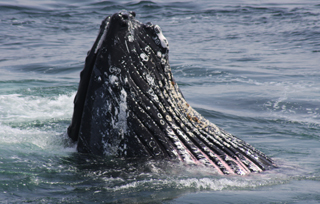
Humpback-Ventral Pleats Extended
On July 17th we sailed into thick fog with light winds and glassy calm seas. Although our visibility was poor, we had an exceptional whale watch with 21 humpbacks, 3 finbacks and 6 minke whales. We identified Crown, Habenero, Monarch, Vulture, Venom, Jabiru, Alphorn, Dome, Rocker, Ampersand, Anvil and calf, Lavalier and calf, Follicle and calf, Reflection and calf and Nile and calf. In order to locate the whales the captains used their radar and frequently stopped in areas where whales had been located the day before. While stopped the crew visually scanned the area while listening for the whale’s exhale. Many of the humpbacks appeared to be searching for prey as they were traveling randomly. Nile and her calf, however, had found a school of sand lance, and Nile was open mouth feeding. The calf most likely had not been weaned and subsequently was not engaging in feeding behaviors. In the afternoon more whales began kick feeding, others, however, were displaying active behaviors such as flipper slapping, breaching and even close boat approaches.
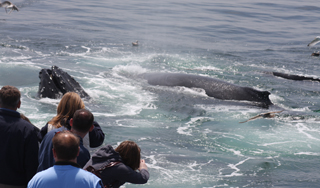
Humpbacks Feeding





